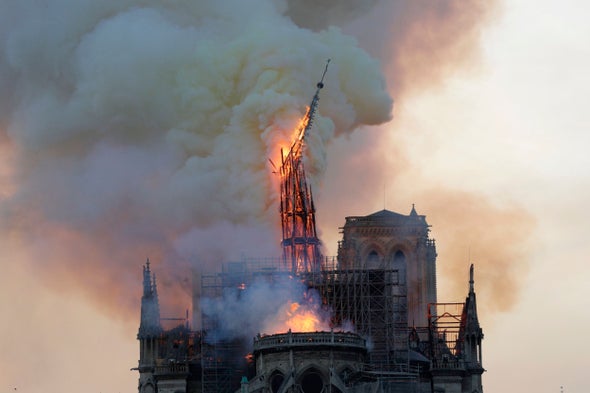The world watched helplessly this week as Paris’s treasured Notre Dame cathedral went up in flames. Although fire brigades managed to save parts of the building, such as the bell towers, the blaze destroyed the roof and spire—along with countless artifacts.
However, this is not the first time Notre Dame has suffered major damage, and the reconstruction project to come (donors have already pledged hundreds of millions of dollars to the effort) is neither the first nor likely the last for the cathedral. “This building is an archaeological palimpsest,” says Dimitris Theodossopoulos, a civil engineer at the University of Edinburgh. “Our generation simply adds something to this, and the next generation will add something else.”
Theodossopoulos specializes in conservation and has studied Gothic vaults as well as the stability of stone walls. Scientific American spoke with him about what remains of Notre Dame, what has been lost, and how its reconstruction will unfold.
What have they managed to save?
It seems that most of the stone fabric is intact. The bells, another important artifact of the cathedral, are housed at the front towers. They were afraid they would melt, and more pieces of history would be lost, but then they managed to stop the fire there. Every major Christian building usually prides themselves on having relics of this and that saint. Some of that was lost; some, since they are movable, were moved away very quickly
And what has been lost?
The whole roof is gone; all the timber elements have gone. The spire, of course, is the most dramatic [loss]. There have been at least a few images of the interior, where we can see damage on the furnishings and decorations. I think all the permanent paintings and sculpture within the cathedral might have been severely damaged because of falling debris or the heat. Most of the religious objects, heavy artifacts that could not be moved—small altarpieces, little chapels, statues, urns, fonts—have been affected. The altar, for example: there was this little video that the fire brigade released, which shows the altar where the services happen being completely destroyed.
What about the stained-glass windows?
It seems that the major rose window on the south façade is intact. But some of the smaller ones, the windows that were closer to the roof, might have deformed. Remember it’s lead [used in the windows], so it melts easily. And maybe also the fact of quick cooling—when you throw water at something very hot—the cold water the fire brigade threw might have even further damaged and cracked some of the stained glass.
How do you repair something like that?
It depends on the damage. For small, round windows, it can be just a matter of salvaging any original fragments and recomposing them. The good thing with Notre Dame is it’s a quite well-documented building, so they may have very good pictures or even drawings of the damaged stained glass. Some of [the windows] might have even been replaced in the major restoration of the mid-19th century. If [the window is] small, it’s just a replacement, a logical composition of what is useful to salvage. If it’s major, like the big rose windows, there’s a structural implication sometimes. If you look up close at a stone window, you can see that all the framing—the mullions that contain the stained glass—are really thin stone beams. And yes, stone is an incombustible material; but with high heat it might start cracking here and there. So, they might have to take it apart and really look at it as a microstructure. This can take a couple of years; it’s quite unique. Understanding how the structure works is very important, then producing the missing stained glass, and then reproducing any stone element. And then putting all that together requires a very delicate operation.
Stone doesn’t burn, but the timber parts of the building did. What role does timber play in the cathedral’s structure?
The stone roofing and the whole stone structure is what we see from the interior. However, these buildings need protection from the elements, so all these cathedrals also have a timber roof. The double-pitched roof you see very often in these buildings is a timber truss, a triangular arrangement of timber beams to form a pitched roof. That’s the broad difference: the roof is timber, all the rest of the structure is stone.
This fire made very clear why stone is important. Because stone is incombustible, it doesn’t burn. But the roof is being pushed outwards as it collapses, and then it drags the fabric [of the building] with it. It’s indirect damage that happens with the stonework: not from the heat itself, but from the collapse of the roof. If you look at the pictures of the interior, you will see this gaping hole right below the spire. The spire collapsed—it was timber covered with lead, so it’s completely flammable—and pierced through the stonework.
How will they start repairing some of this damage?
Even if there are any pieces of timber left behind, this has more of an archaeological value, so they would take them aside and salvage them. First of all, they have to secure the stone fabric. Because—as the wall was collapsing and deforming and opening up, and as they are going to remove the timbers—chances are that the top edge of the building will be very delicate. So, the first thing they will have to do is brace the stoneworks, apply probably a very big long bracing on all the top of the cathedral. [This is] similar to what they did in another important church, St. Francis of Assisi, that was damaged in ’97 in Italy. The bracing cancels deformations, and also bonds the building a bit better together. So that will be the first step, and then they will have to think about the roof. We’re talking about north of France, which can snow very heavily, so that means a high-pitched, permanent roof.
Many cathedrals like Reims and Soissons were destroyed in the First World War at the borders with Germany and Belgium, where the major battles happened. Again, the fire destroyed the soft elements like the timber, but the stonework remained. In Reims, there was this project of reconstructing the roof with concrete ribs instead of having a timber truss, as with most cathedrals at the time. This guy [architect Henri Deneux] built a roof like the keel of a ship upside down, but with fireproof concrete ribs, very much in line with the fireproofing of stone vaults. Concrete is heavier than timber, but the sections were thinner, and that meant that the weight of the new concrete roof was similar to the weight of the traditional timber roof. That could be a solution, a way forward.
Do you think they would do that here in Notre Dame?
I would strongly recommend it because it bypasses [the fire] problem. This could happen again—it will not happen in 30 years, because we will be very alert, but a lead replacement in 40, 50 years might cause exactly the same problem. It’s like a lesson to everybody that we can apply innovations to these buildings, can further secure them in the future, and bypass all the problems that timber has been bringing. Fireproofing completely is the first priority.
How will they make the restoration authentic?
All these major cathedrals have gone through so many phases. The original construction of the cathedral—which was already modifying earlier phases—was completely concluded around the 13th century, over 100, 150 years. Then many modifications happened. Each of [these phases] is authentic in its own merits, because it represents the ambitions of the period, the technology of the period, how people would understand or misunderstand the building—historical cultural importance. So, it is very important to understand the weighting of each of these phases into the current image we have about conservation.
There was major damage after the French Revolution, and then a major restoration in the mid-19th century, which triggered a lot of debate. [Eugène] Viollet-le-Duc was an engineer, and he would pick up a style that he thought was the right one—Gothic, for him—and he would kind of force the remnants of the building to follow that. As you do that, since the science of archaeology was not very well-developed back then, of course you make many mistakes. Even with some not-very-correct premises, the 19th-century restoration managed to see the building as a whole—this vast conglomerate of arts, architecture, history, and cultural significance—and they applied a holistic approach. It is a paradigm of restoration which you find often in conservation books
My understanding now is that it will again go through a holistic approach. They will review everything that happens: the daily religious life of the building, its culture significance, the flow for tourists, safety—many things will be put on the table. Some of it might bypass or sideline some of the original features in order to promote modern ones. I think it should be once again an emblematic restoration, in the sense that it should create debate. It should attract the best engineers, the best materials, important innovation. This building is an archaeological palimpsest. Our generation simply adds something to this, and the next generation will add something else. It’s an ongoing thing we need to consider.




No comments:
Post a Comment